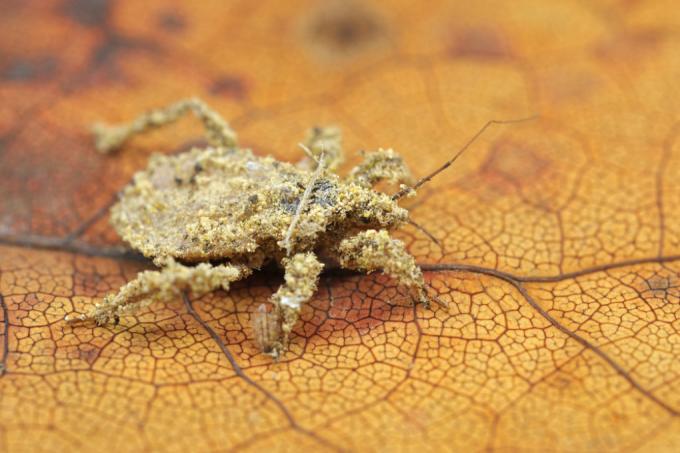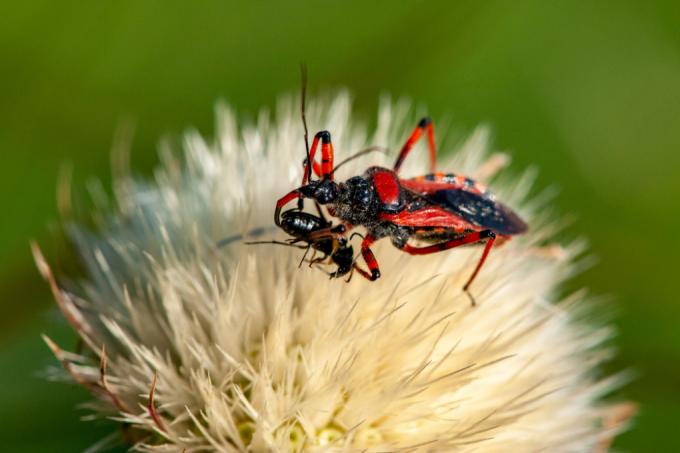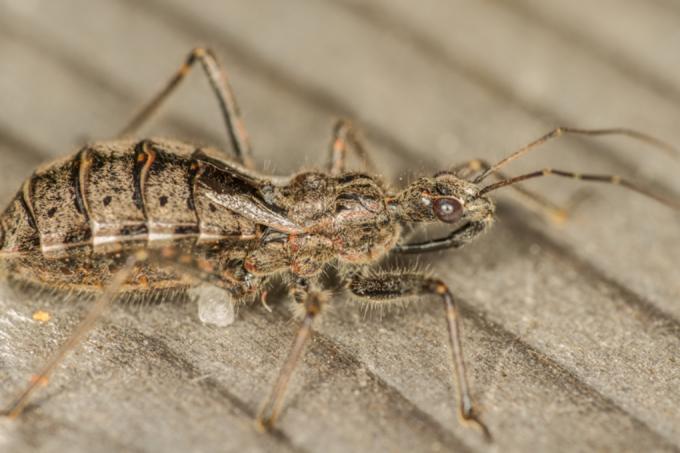the essentials in brief
- Predatory bugs in Germany are 3.5 mm to 19 mm in size, have a strong, forward curved trunk, elliptical-oval to elongated-slender bodies and different colors from red-orange with black spots to gray-brown-beige.
- Predatory bugs can become a nuisance in the home and can cause painful stings when in danger.
- Combat in the house: catch with a glass trick, dispel with intense smells, spray with soft soap solution or the organic spray neem.
Are there predatory bugs in Germany?
So far, 20 predatory bug species are represented in Germany. Around the globe, more than 7,000 species populate a wide variety of habitats. The name refers to a predatory way of life. Predatory bugs are always on the hunt for all kinds of tiny insects Spider mites to mighty spiders. Against this background, domestic predatory bugs are to be rated as beneficial insects, because the prey scheme includes a variety of pests indoors and outdoors. Admittedly, the appreciation is not unclouded. As a hunting weapon, predatory bugs have a powerful trunk on board. If predatory bedbugs feel threatened by a person, they will feel this proboscis painfully.
also read
- Dormouse droppings - tips on appearance, identification and disposal
- Running ducks - informative tips on buying, keeping and caring for them
- This is how ducks feel at home in the garden - tips for keeping running ducks
Identify predatory bugs - tips.

The dust bug camouflages itself with dust
Predatory bugs in Germany differ considerably in size, color, body shape and occurrence. The largest Central European species called the dust bug is a giant with almost 2 centimeters compared to the 3.5 millimeter small mosquito bug. The following table gives an overview of helpful identifying features of 5 common predatory bug species:
| Predatory bugs Germany | Dust bug | Murder bug | Short-winged predatory bug | Pirate robbery bug | Mosquito bug |
|---|---|---|---|---|---|
| size | 15-19 mm | 14-17 mm | 9-12 mm | 9-12 mm | 3.5-7 mm |
| colour | black to black-brown | red with pattern | gray-brown | shiny red-black | gray-brown |
| body shape | elliptical | elongated | elongated, slender | very small | Mosquito-like |
| Special feature | very hairy | red-black spotted margin | Label with a thorn | red-orange wings with black spots | very long legs |
| activity | nocturnal | diurnal | diurnal | nocturnal | diurnal |
| Occurrence | in the house | in the garden | in the garden | in the garden, in the house | in the shade, in the apartment |
| Botanical name | Reduvius personatus | Rhynocoris iracundus | Coranus subapterus | Peirates hybridus | Empicoris vagabundus |
| Middle name | Masked rascal | Red murder bug | none | none | none |
In the following species portraits you can read more detailed information on the appearance, when and where the predatory bugs can often be found in Germany.
Dust bug (Reduvius personatus)
As the largest predatory bug in Germany, the dust bug spreads fear and terror. On the nightly hunt for flies, bugs and vermin, the imposing dust bug hits windows and doors when the light suddenly comes on. The second name 'masked rascal' refers to the ingenious camouflage behavior of the larvae. After each molt, a larva loads its body with dust and thus becomes almost invisible.
- Where to find it: in the house, in the attic, in the stable or tool shed, outside in tree hollows, abandoned bird nests
- When to find: indoors all year round, outdoors from May to September
Murder Bug (Rhynocoris iracundus)

The murder bug is only dangerous to other insects
The name makes the blood of sensitive hearts run cold. At this point, the all-clear can be given immediately. The murder bug is dangerous or even fatal for beetle larvae or caterpillars. Careless bees and sawfly are also attacked. A black and red patterned top and red, black dotted underside simplify the determination for the inexperienced eye. Admiring and taking photos is allowed. Touching or taking in hand is punished by a murder bug with a painful bite.
- Where to find: in the garden on blossoms (umbellate blossoms), in the herb layer
- When to find: June to September
In the following video you experience a murder bug on the prowl in the garden:
Youtube
Short-winged predatory bug (Coranus subapterus)
In comparison with its conspecifics, the short-winged predatory bug is out of the ordinary in some respects. Inconspicuous gray-brown color and a very slender body make it difficult to identify the species as a predatory bug. On closer inspection, a yellow vertical line can be seen on the movable head. The bug boasts a yellow thorn on its label. The predatory bug owes its name to rudimentary, short wings. Adults, larvae and eggs are tough. Because the mating season does not take place until late autumn, the eggs are frost-resistant.
- Where to find: in the sandy, full sun rock garden, often under sand thyme cushions, mullein, sagebrush
- When to find: March to November (eggs also in winter)
Pirate Robber Bug (Peirates hybridus)
The pirate robber bug hijacks other bugs under cover of darkness and sucks their life out of them. In the course of global warming, the colorful predatory bug species has penetrated as far as the Upper Rhine Rift. Because they hibernate as adult bugs, Peirates hybridus cheekily invade buildings in autumn in search of winter quarters. The head, pronotum and legs are glossy black. The red-orange, black-spotted wings shine conspicuously towards the hobby gardener when he comes across a day hiding place while working in the garden.
- Where to find it: on the ground in the rock garden, on the dry stone wall in full sun, in the apartment in winter
- When to find: outside from June to August, inside from September
Mosquito bug (Empicoris vagabundus)
Is that a mosquito or a predatory bug? In the search for an answer to the knowledgeable determination, keep an eye out for the typical, arching trunk between two ringed antennae. Another distinguishing feature is an upright thorn on the label. Of its six long legs, the two front legs are particularly strong.
- Where to find: on deciduous and coniferous trees in shady niches
- When to find: all year round in the garden, often on trees of life and in the house
Digression
Chagas disease on the rise

A "Chagas bug" bite can be fatal
A predatory bug bite in the tropics is dangerous because Chagas disease is lurking. This sting can cause predatory bugs of the species Triatoma infestans to sink their proboscis into human skin transmit the parasite Trypanosoma cruzi to the victim, the causative agent of the dreaded Chagas disease. The most common symptoms of the infection are fever, abdominal pain, enlarged liver and an inflammation of the heart muscle, which in the worst case ends fatally. Fatally, Chagas can also be transmitted from person to person, for example as part of a blood donation. It is estimated that around 2,000 people in Germany are now infected with Chagas disease - and the number is rising. Thomas Zoller from the German Chagas project ELCiD draws attention to this. With this in mind, keeping exotic predatory bugs indoors becomes a risky endeavor.
Predatory bugs in the apartment - what to do?
Predatory bug infestation in the house should not be taken lightly. Direct exposure to some species can have painful consequences. The sting of a dust bug or pirate bug can be just as painful as a wasp sting. What to do? How to fight predatory bugs in the apartment without poison:
| Predatory bug control | method |
|---|---|
| Glass trick | catch, release outside |
| To evict | distribute essential fragrances |
| Home remedies | Soft soap solution |
| Organic insecticide | Neem |
Please do not use the vacuum cleaner to fight predatory bugs in the house. Numerous types of bedbugs have a stinking defense secretion on board that sticks in the device for a long time. You can find additional information on the correct procedure in the following sections:
Glass trick - this is how it works

If a bug gets inside, it can be caught with a glass and transported outside
In Germany, domestic predatory bugs in the house are not dangerous for people or pets. However, the vicious beasts can be a nuisance. The glass trick is helpful and animal-friendly so that the pests' radius of action is shifted from inside to outside. That is how it goes:
- Put the glass over the predatory bug
- Carefully slide a sheet of paper or thin cardboard under the glass
- Run under the paper with one hand and stabilize the glass with the other hand
- Carry the predator bug outside in a jar and release it alive
It is even easier with the Snapy live catcher for insects, which is now standard equipment in near-natural households.
Drive away predatory bugs
Intense smells drive numerous insects out of the house, including brazen predatory bugs. First and foremost, acidic and ethereal scents attack the olfactory sense of bedbugs, which then prefer to run away. What about the dreaded stink bug that Marbled stink bug, helps, does not leave the dust bug and the like without a trace. The following tips have proven to be effective in combating and preventing:
- vinegar: Regularly rub window and door frames, surfaces in the home or clean with vinegar cleaner
- lemon: Use citronella products in the home with Cloves Place peppered lemon wedges on the windowsill
- juniper: Laying branches of juniper, camphor and other plants with essential ingredients
Tips
Harmless fire bugs (Pyrrhocoris apterus) and meek strip bugs (Graphosoma lineatum) are confusingly similar to the red murder bug and some harmful red beetles. So that the innocent plant suckers do not pay for this similarity with life, please take a close look before you take control measures.
Make home remedies yourself - recipe and application

Home remedies are especially effective for bug nymphs, i.e. baby bugs
Predatory bugs give in when a tried and tested home remedy is used. Classic soft soap solution fights adult bedbugs, larvae and eggs without poison. The ingredients for the following recipe are on the kitchen shelf:
- Heat 1 liter of water in a kettle
- 2-3 tbsp organicSoft soap(€ 38.88 at Amazon *) stir in
- Add a dash of alcohol
- Let the solution cool down and pour it into a Pressure sprayer to fill
Use the home remedy as an organic insecticide against predatory bugs. In particular, spray larvae and eggs that you discover in the apartment. When looking for the larvae, please note that they are nymphs, i.e. predatory bugs in miniature format and not maggots like flies or Beetles.
Neem versus predatory bugs in the house
If the jar trick proves to be too time-consuming and the home remedy too harmless, neem oil comes into play. The Indian neem tree (Azadirachta indica) defends itself against pests with its main ingredient azadirachtin. Ever since curious researchers found out that the active ingredient also makes bugs, lice and other vermin harmless, neem oil has taken a leading position worldwide as a bio-insecticide. In Germany, the product is available under various trade names, such as Naturen Bio-Pest-Free Neem or Insect-Free Neem from Compo.
It is important to note that insecticides based on neem oil do not have an immediate effect. Rather, the active ingredient intervenes in the development of predatory bugs. In the case of larvae, further molting is stopped so that they die within a few days. Fertility disorders occur in adult predatory bugs. The number of eggs laid is significantly reduced. Isolated infestations with predatory bedbugs can therefore not develop into a plague.
frequently asked Questions
What do predatory bugs look like?
Despite a manageable number of around 20 species, predatory bugs differ significantly in Germany. The sizes range from a tiny 3.5 mm to a tight 19 mm. Some species have red-orange colors as a warning, other species prefer an inconspicuous, gray-brown color. Common features are a distinctive, arched trunk, an elongated, flexible head and 2 particularly strong legs at the front as robotic legs.
Is a robber bug bite dangerous to humans?
Predatory types of bedbugs harbor a certain potential for danger to humans. If predatory bugs feel threatened, they sting with their long proboscis. This can be very painful and excruciatingly itchy. The tropical species Triatoma infestans is really dangerous because it can transmit the pathogens of Chagas disease with its bite.
What should be considered when keeping predatory bugs as pets?
An escape-proof terrarium or aquarium is best suited for keeping it. Terrarium soil, coconut oil and a mix of peat and sand, naturally free of fertilizer residues or pesticides, are recommended as substrates. Please provide a number of hiding spots, such as pieces of cork or small branches. A drinking bowl with fresh water is part of the basic equipment for species-appropriate keeping, because predatory bugs are thirsty swallowing woodpeckers. A temperature of 25 ° -30 ° Celsius during the day and 20 ° Celsius at night ensures active, healthy animals. Are on the menu Crickets, small cockroaches or crickets.
Which predatory bug species are suitable for keeping in the terrarium?
Exotic predatory bugs, which are significantly larger and more colorful than native species, are popular for keeping. The species of the genus Platymeris from Africa with a size of an impressive 40 mm are very popular. These include the white-spot predatory bug (Platymeris biguttatus), which displays two large white spots on its shiny black body. The popular predatory bug Platymeris laevicollis sets itself apart with red spots and red-banded, black legs. The magnificent Platymeris rhadamanthus comes from the African Sahara and inspires with orange spots and red thigh bands.
Tips
A green soft bug considers itself a predatory bug and is often used in biological pest control. The species Macrolophus caliginosus kills the dreaded whitefly in the greenhouse. These pests often attack tomato plants and other nightshade plants. For this reason, the specialist trade has simply declared the soft bugs to be predatory bugs and is offering the beneficial insects for sale.
